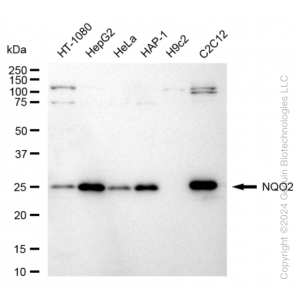| Reactivity: | Human, Mouse |
| Applications: | WB, IC |
| Host Species: | Rabbit |
| Isotype: | IgG |
| Clonality: | Monoclonal antibody |
| Gene Name: | N-ribosyldihydronicotinamide:quinone dehydrogenase 2 |
| Gene Symbol: | NQO2 |
| Synonyms: | QR2; DHQV; DIA6; NMOR2 |
| Gene ID: | 4835 |
| UniProt ID: | P16083 |
| Clone ID: | 24GB250 |
| Immunogen: | A synthesized peptide derived from human NQO2 |
| Dilution: | WB 1:1,000-1:5,000; IC 1:100-1:1,000 |
| Purification Method: | Affinity purified |
| Concentration: | Lot dependent |
| Buffer: | PBS with 0.09% Sodium azide, 50% glycerol, pH7.3. |
| Storage: | Store at -20°C. Avoid freeze/thaw cycles. |
Background
This gene encodes a member of the thioredoxin family of enzymes. It is a cytosolic and ubiquitously expressed flavoprotein that catalyzes the two-electron reduction of quinone substrates and uses dihydronicotinamide riboside as a reducing coenzyme. Mutations in this gene have been associated with neurodegenerative diseases and several cancers. Alternative splicing results in multiple transcript variants.
Images
 | Western blotting analysis using anti-NQO2 antibody (Cat#62309). Total cell lysates (30 μg) from various cell lines were loaded and separated by SDS-PAGE. The blot was incubated with anti-NQO2 antibody (Cat#62309, 1:5,000) and HRP-conjugated goat anti-rabbit secondary antibody (Cat#201, 1:20,000) respectively. Image was developed using FeQ™ ECL Substrate Kit (Cat#226). |
 | Western blotting analysis using anti-NQO2 antibody (Cat#62309). NQO2 expression in wild type (WT) and NQO2 shRNA knockdown (KD) HeLa cells with 20 μg of total cell lysates. Hsp90 α serves as a loading control. The blot was incubated with anti-NQO2 antibody (Cat#62309, 1:5,000) and HRP-conjugated goat anti-rabbit secondary antibody (Cat#201, 1:20,000) respectively. Image was developed using NaQ™ ECL Substrate Kit (Cat#716). |
 | Immunocytochemical staining of HepG2 cells with anti-NQO2 antibody (Cat#62309, 1:1,000). Nuclei were stained blue with DAPI; NQO2 was stained magenta with Alexa Fluor® 647. Images were taken using Leica stellaris 5. Protein abundance based on laser Intensity and smart gain: Low. Scale bar: 20 μm. |
You may also be interested in:

